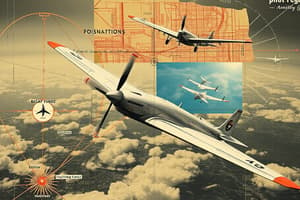Podcast
Questions and Answers
In the event of a rejected takeoff, which signal from the Captain indicates that an evacuation is unlikely?
In the event of a rejected takeoff, which signal from the Captain indicates that an evacuation is unlikely?
- "This is the Captain, Emergency Descent"
- "This is the Captain, Evacuate, Evacuate"
- "This is the Captain, Everyone remain seated" (correct)
- "This is the Captain, Cabin Crew to your stations"
The 'Brace' signal from the Captain is given approximately 60 seconds before impact.
The 'Brace' signal from the Captain is given approximately 60 seconds before impact.
False (B)
What is the primary purpose of the 'Cabin Emergency Call' signal initiated by the Captain?
What is the primary purpose of the 'Cabin Emergency Call' signal initiated by the Captain?
To summon the Cabin Manager to the flight deck to communicate the nature of an emergency.
The Captain uses the command, 'This is the Captain, ______' to indicate that a rapid descent will commence, and Cabin Crew must complete immediate drills during the rapid depressurisation.
The Captain uses the command, 'This is the Captain, ______' to indicate that a rapid descent will commence, and Cabin Crew must complete immediate drills during the rapid depressurisation.
Match the Captain's PA commands with their corresponding actions by the cabin crew:
Match the Captain's PA commands with their corresponding actions by the cabin crew:
Following a period of rapid depressurization, which signal from the Captain indicates that cabin crew may commence follow-up drills?
Following a period of rapid depressurization, which signal from the Captain indicates that cabin crew may commence follow-up drills?
If the Captain announces, "This is the Captain, Cabin Crew to your stations," an evacuation is immediately underway.
If the Captain announces, "This is the Captain, Cabin Crew to your stations," an evacuation is immediately underway.
Describe the specific actions cabin crew should undertake upon hearing the Captain's command: 'This is the Captain, Emergency Descent'.
Describe the specific actions cabin crew should undertake upon hearing the Captain's command: 'This is the Captain, Emergency Descent'.
Under which of the following circumstances are cabin crew authorized to initiate an evacuation without awaiting the Captain's order?
Under which of the following circumstances are cabin crew authorized to initiate an evacuation without awaiting the Captain's order?
The command 'This is the Captain, Cabin Crew Stand Down' is used to signal the start of an evacuation.
The command 'This is the Captain, Cabin Crew Stand Down' is used to signal the start of an evacuation.
Describe the evacuation commands given by the Cabin Crew once the passengers are at the exit.
Describe the evacuation commands given by the Cabin Crew once the passengers are at the exit.
In the event of a ditching, it indicates that __________.
In the event of a ditching, it indicates that __________.
Match the evacuation scenarios with the appropriate crew actions:
Match the evacuation scenarios with the appropriate crew actions:
What is the significance of cabin crew repeating the exit command twice before starting evacuation commands?
What is the significance of cabin crew repeating the exit command twice before starting evacuation commands?
What information is being relayed when Cabin Crew say 'This is the Captain, Evacuate, Evacuate'?
What information is being relayed when Cabin Crew say 'This is the Captain, Evacuate, Evacuate'?
After confirming all passengers have evacuated their area, which command do cabin crew use to communicate their status to the rest of the team?
After confirming all passengers have evacuated their area, which command do cabin crew use to communicate their status to the rest of the team?
Flashcards
Cabin Emergency Call
Cabin Emergency Call
A command by the Captain via PA for the Cabin Manager to report to the Flight Deck in an emergency.
Brace Signal
Brace Signal
A command by the Captain via PA to signal cabin crew to brace for impact before landing.
Evacuation Signal
Evacuation Signal
A command by the Captain via PA to instruct Cabin Crew to evacuate the aircraft.
Rapid Depressurisation Signal
Rapid Depressurisation Signal
Signup and view all the flashcards
Follow up Depressurisation Signal
Follow up Depressurisation Signal
Signup and view all the flashcards
Evacuation Unlikely
Evacuation Unlikely
Signup and view all the flashcards
Evacuation Likely
Evacuation Likely
Signup and view all the flashcards
Evacuation Unnecessary
Evacuation Unnecessary
Signup and view all the flashcards
Cabin Crew Stand Down
Cabin Crew Stand Down
Signup and view all the flashcards
Evacuate Command
Evacuate Command
Signup and view all the flashcards
Initial Commands
Initial Commands
Signup and view all the flashcards
Exit Commands
Exit Commands
Signup and view all the flashcards
Evacuation Commands
Evacuation Commands
Signup and view all the flashcards
Final Commands
Final Commands
Signup and view all the flashcards
Cabin Crew Initiated Evacuation
Cabin Crew Initiated Evacuation
Signup and view all the flashcards
Ditching
Ditching
Signup and view all the flashcards
Study Notes
Primary Signals - Pilots Signalling Cabin Crew
-
Cabin Emergency Call: Used in emergencies, the Captain instructs the Cabin Manager to report to the flight deck immediately via the PA system.
- Example: "This is the Captain, Cabin Manager report to the Flight Deck immediately"
-
Brace Signal: Warned 30 seconds before impact, the Captain alerts the cabin to prepare for landing via the PA system.
- Example: "This is the Captain, Brace, Brace"
-
Evacuation Signal: The Captain uses the PA system to order an evacuation.
- Example: "This is the Captain, Evacuate, Evacuate"
-
Rapid Depressurisation Signal: Indicates a rapid descent, requiring immediate drills by cabin crew during the depressurization event.
- Example: "This is the Captain, Emergency Descent"
-
Follow up Depressurisation Signal: Cabin crew know drills can stop when the Captain signals this.
- Example: "This is the Captain, Oxygen is no longer required"
Other Signals (Ground Signals)
-
Evacuation Unlikely: The Captain signals this most often after a rejected takeoff, requiring crew to remain seated via the PA system, followed by further announcements.
- Example: "This is the Captain, Everyone remain seated"
-
Evacuation Likely: Captain alerts crew that evacuation may be necessary, sending crew to their stations for preparation.
- Example: "This is the Captain, Cabin Crew to your stations"
-
Evacuation Unnecessary: Captain's command to cease evacuation preparations.
- Example: "Cabin Crew Stand Down, Cabin Crew Stand Down" (Note: This is the only command not starting with "This is the Captain".)
-
Evacuation Necessary: (Once crew at stations): Captain orders an evacuation.
- Example: "This is the Captain, Evacuate, Evacuate"
Cabin Crew Commands Used in Evacuation
-
Initial Commands: Repeated until all exits are open; crew checks external conditions and opens exits.
-
Exit Commands: Given when exits are open to direct passengers. Repeated twice.
-
Evacuation Commands: Specific instructions on how to exit the aircraft, stated twice.
- Example: "Hurry come this way, Hurry come this way, Get out, move well away, Get out, move well away."
-
Final Commands: Confirmation of all passengers leaving the area, communication with other crew members.
Situations Allowing Cabin Crew to Initiate Evacuation
- Aircraft breakdown/crash
- Landing in water
- Significant cabin fire on the ground
- Unable to contact Captain or Cabin Manager.
- Important Note: In these situations, immediate evacuation is crucial.
Evacuation Types
-
Prepared Evacuation: Crew and passengers are briefed beforehand.
-
Unprepared Evacuation: No time for pre-briefing.
-
Ditching is also noted as a possible trigger for cabin crew initiated evacuation.
Studying That Suits You
Use AI to generate personalized quizzes and flashcards to suit your learning preferences.




